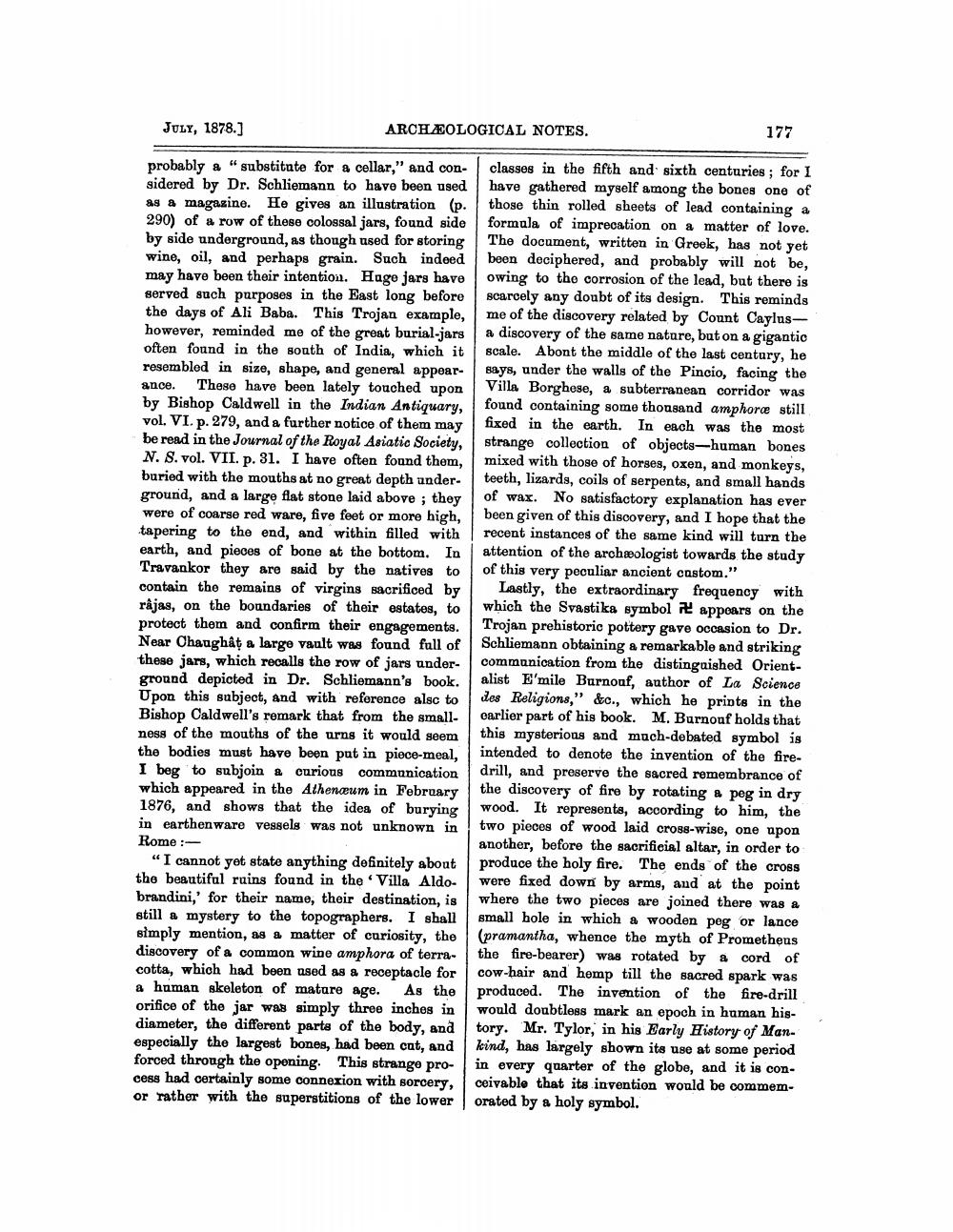________________
JULY, 1878.)
ARCHÆOLOGICAL NOTES.
177
probably a “substitute for a cellar," and con- sidered by Dr. Schliemann to have been used as a magazine. He gives an illustration (p. 290) of a row of these colossal jars, found side by side underground, as though used for storing wine, oil, and perhaps grain. Such indeed may have been their intention. Hage jars have served such purposes in the East long before the days of Ali Baba. This Trojan example, however, reminded me of the great burial.jars often found in the south of India, which it resembled in size, shape, and general appearance. These have been lately touched upon by Bishop Caldwell in the Indian Antiquary, vol. VI. p. 279, and a further notice of them may be read in the Journal of the Royal Asiatic Society, N. S. vol. VII. p. 31. I have often found them, buried with the mouths at no great depth under. ground, and a large flat stone laid above, they were of coarse red ware, five feet or more high, tapering to the end, and within filled with earth, and pieces of bone at the bottom. In Travankor they are said by the natives to contain the remains of virgins sacrificed by râjas, on the boundaries of their estates, to protect them and confirm their engagements. Near Chaughåt a large vault was found full of these jars, which recalls the row of jars underground depicted in Dr. Schliemann's book. Upon this subject, and with reference alsc to Bishop Caldwell's remark that from the smallness of the mouths of the urns it would seem the bodies must have been put in piece-meal, I beg to subjoin & curious communication which appeared in the Athenceum in February 1876, and shows that the idea of burying in earthenware vessels was not unknown in Rome :
"I cannot yet state anything definitely about the beautiful rains found in the Villa Aldobrandini,' for their name, their destination, is still a mystery to the topographers. I shall simply mention, as a matter of curiosity, the discovery of a common wine amphora of terra. cotta, which had been used as a receptacle for a human skeleton of mature age. As the orifice of the jar was simply three inches in diameter, the different parts of the body, and especially the largest bones, had been cut, and forced through the opening. This strange process had certainly some connexion with sorcery, or rather with the superstitions of the lower
classes in the fifth and sixth centuries; for I have gathered myself among the bones one of those thin rolled sheets of lead containing a formula of imprecation on a matter of love. The document, written in Greek, has not yet been deciphered, and probably will not be, owing to the corrosion of the lead, but there is scarcely any doubt of its design. This reminds me of the discovery related by Count Caylusa discovery of the same nature, but on a gigantic scale. Abont the middle of the last century, he says, under the walls of the Pincio, facing the Villa Borghese, a subterranean corridor was found containing some thousand amphorce still fixed in the earth. In each was the most strange collection of objects-human bones mixed with those of horses, oxen, and monkeys, teeth, lizards, coils of serpents, and small hands of wax. No satisfactory explanation has ever been given of this discovery, and I hope that the recent instances of the same kind will turn the attention of the archæologist towards the study of this very peculiar ancient custom."
Lastly, the extraordinary frequency with which the Svastika symbol rappoars on the Trojan prehistoric pottery gave occasion to Dr. Schliemann obtaining a remarkable and striking communication from the distinguished Orientalist Emile Burnouf, author of La Science des Religions," &c., which he prints in the earlier part of his book. M. Burnouf holds that this mysterious and much-debated symbol is intended to denote the invention of the firedrill, and preserve the sacred remembrance of the discovery of fire by rotating a peg in dry wood. It representa, according to him, the two pieces of wood laid cross-wise, one apon another, before the sacrificial altar, in order to produce the holy fire. The ends of the cross were fixed down by arms, and at the point where the two pieces are joined there was a small hole in which a wooden peg or lance (pramantha, whence the myth of Prometheus the fire-bearer) was rotated by a cord of cow hair and hemp till the sacred spark was produced. The invention of the fire-drill would doubtless mark an epoch in human history. Mr. Tylor, in his Early History of Mankind, has largely shown its use at some period in every quarter of the globe, and it is conceivable that its invention would be commemorated by a holy symbol.




